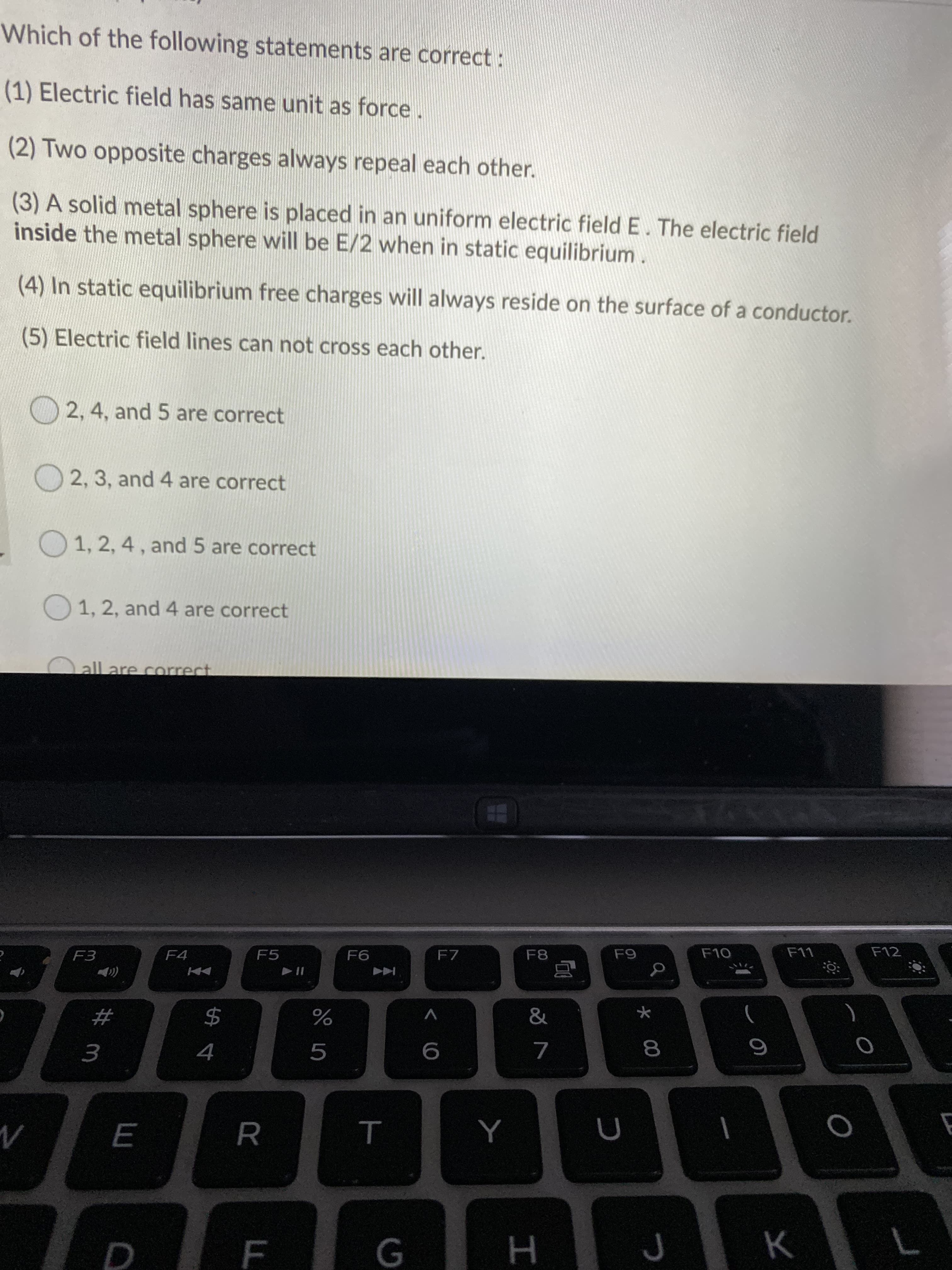Which of the following statements are correct: (1) Electric field has same unit as force. (2) Two opposite charges always repeal each other. (3) A solid metal sphere is placed in an uniform electric field E. The electric field inside the metal sphere will be E/2 when in static equilibrium. (4) In static equilibrium free charges will always reside on the surface of a conductor. (5) Electric field lines can not cross each other. 2, 4, and 5 are correct O 2, 3, and 4 are correct O 1, 2, 4, and 5 are correct O 1, 2, and 4 are correct all are correct F3 F4 F5 F6 F7 F8 F9 F10 F11 F12 )) 24 & 4 6. 8 R т E F н
Which of the following statements are correct: (1) Electric field has same unit as force. (2) Two opposite charges always repeal each other. (3) A solid metal sphere is placed in an uniform electric field E. The electric field inside the metal sphere will be E/2 when in static equilibrium. (4) In static equilibrium free charges will always reside on the surface of a conductor. (5) Electric field lines can not cross each other. 2, 4, and 5 are correct O 2, 3, and 4 are correct O 1, 2, 4, and 5 are correct O 1, 2, and 4 are correct all are correct F3 F4 F5 F6 F7 F8 F9 F10 F11 F12 )) 24 & 4 6. 8 R т E F н
Physics for Scientists and Engineers, Technology Update (No access codes included)
9th Edition
ISBN:9781305116399
Author:Raymond A. Serway, John W. Jewett
Publisher:Raymond A. Serway, John W. Jewett
Chapter25: Electric Potential
Section: Chapter Questions
Problem 25.52P: Lightning can be studied with a Van de Graaff generator, which consists of a spherical dome on which...
Related questions
Question

Transcribed Image Text:Which of the following statements are correct:
(1) Electric field has same unit as force.
(2) Two opposite charges always repeal each other.
(3) A solid metal sphere is placed in an uniform electric field E. The electric field
inside the metal sphere will be E/2 when in static equilibrium.
(4) In static equilibrium free charges will always reside on the surface of a conductor.
(5) Electric field lines can not cross each other.
2, 4, and 5 are correct
O 2, 3, and 4 are correct
O 1, 2, 4, and 5 are correct
O 1, 2, and 4 are correct
all are correct
F3
F4
F5
F6
F7
F8
F9
F10
F11
F12
))
24
&
4
6.
8
R
т
E
F
н
Expert Solution
This question has been solved!
Explore an expertly crafted, step-by-step solution for a thorough understanding of key concepts.
Step by step
Solved in 2 steps with 1 images

Recommended textbooks for you

Physics for Scientists and Engineers, Technology …
Physics
ISBN:
9781305116399
Author:
Raymond A. Serway, John W. Jewett
Publisher:
Cengage Learning

Principles of Physics: A Calculus-Based Text
Physics
ISBN:
9781133104261
Author:
Raymond A. Serway, John W. Jewett
Publisher:
Cengage Learning

College Physics
Physics
ISBN:
9781938168000
Author:
Paul Peter Urone, Roger Hinrichs
Publisher:
OpenStax College

Physics for Scientists and Engineers, Technology …
Physics
ISBN:
9781305116399
Author:
Raymond A. Serway, John W. Jewett
Publisher:
Cengage Learning

Principles of Physics: A Calculus-Based Text
Physics
ISBN:
9781133104261
Author:
Raymond A. Serway, John W. Jewett
Publisher:
Cengage Learning

College Physics
Physics
ISBN:
9781938168000
Author:
Paul Peter Urone, Roger Hinrichs
Publisher:
OpenStax College

College Physics
Physics
ISBN:
9781285737027
Author:
Raymond A. Serway, Chris Vuille
Publisher:
Cengage Learning

College Physics
Physics
ISBN:
9781305952300
Author:
Raymond A. Serway, Chris Vuille
Publisher:
Cengage Learning

Physics for Scientists and Engineers: Foundations…
Physics
ISBN:
9781133939146
Author:
Katz, Debora M.
Publisher:
Cengage Learning